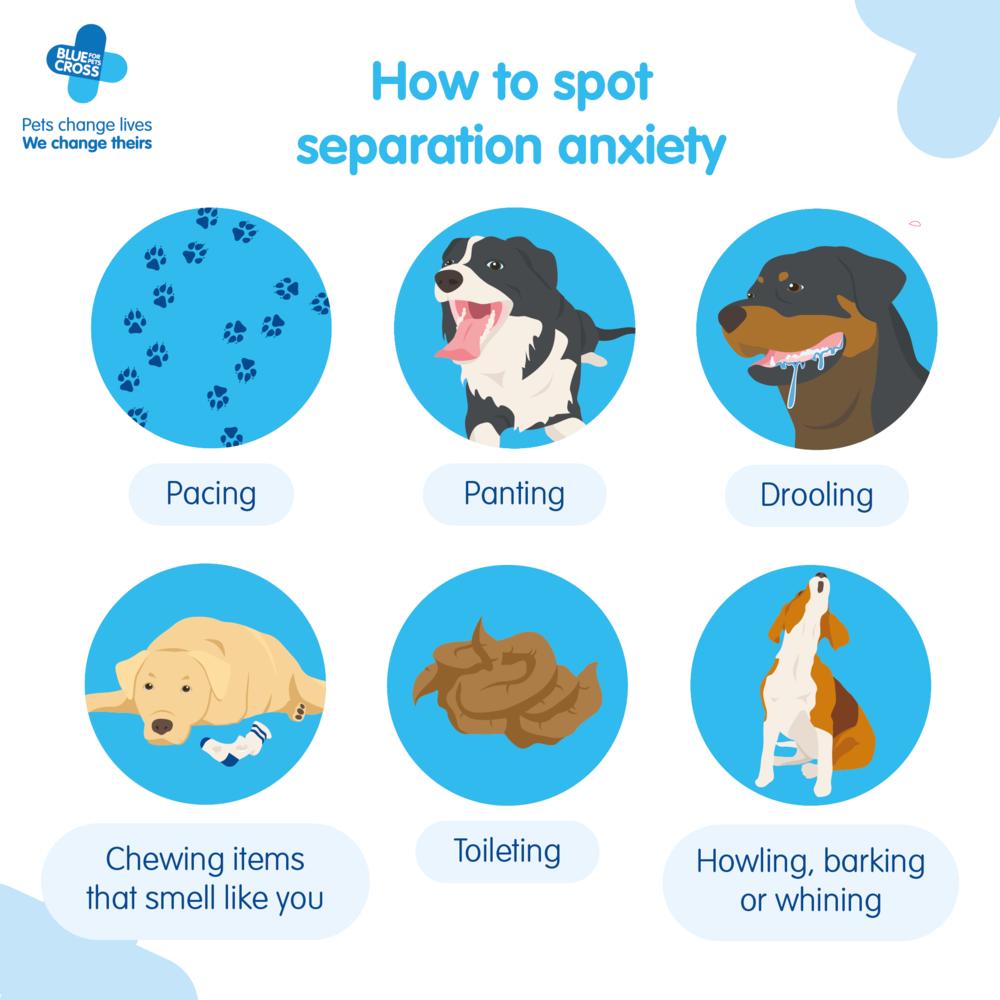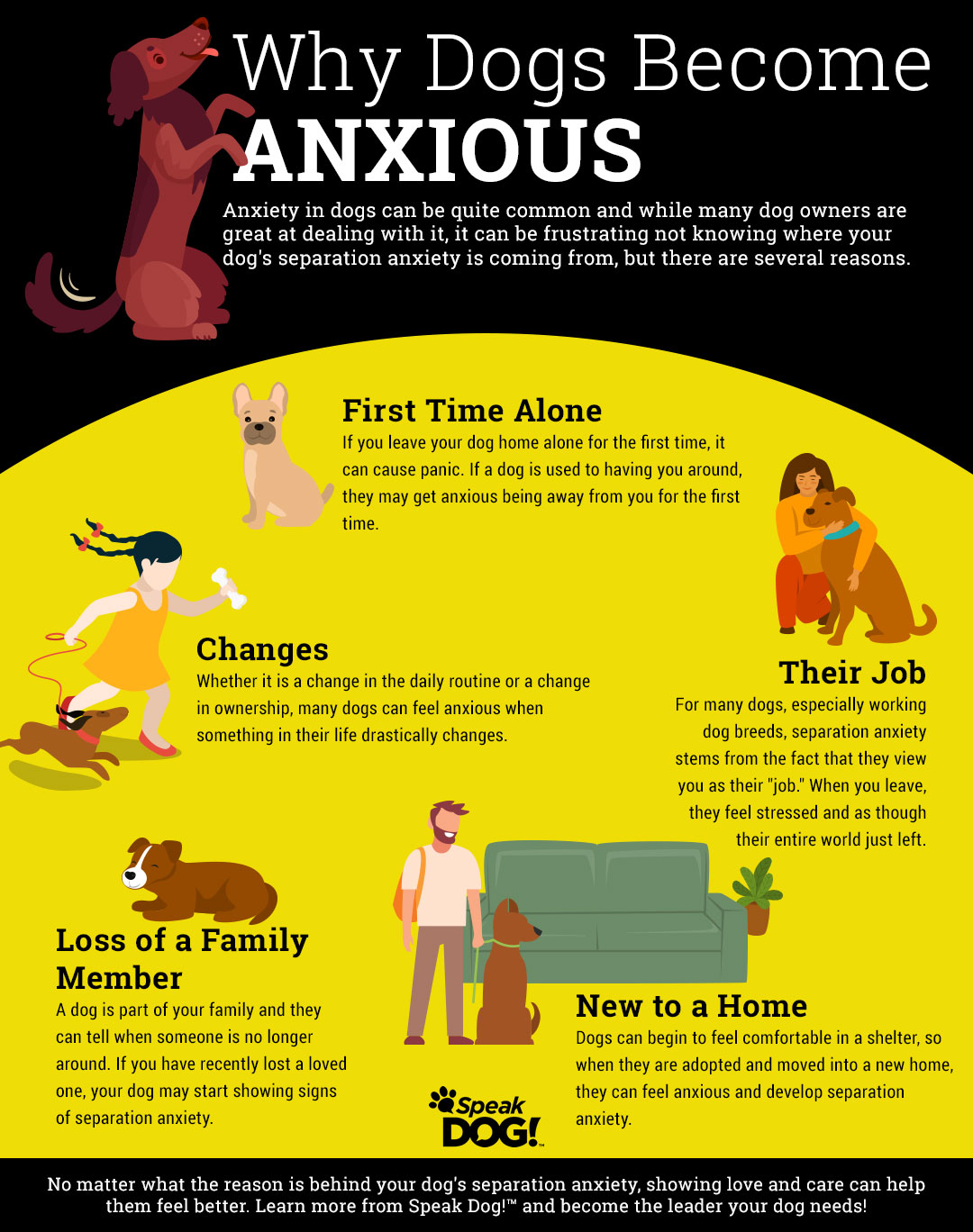Your dog may have separation anxiety if it shows excessive distress and behavior problems when alone. Signs include persistent barking, destruction, and attempts to escape.
Separation anxiety in dogs is a condition where canines exhibit stress-related behaviors in the absence of their owners. This can manifest through excessive barking, whining, or howling, as well as more destructive actions such as chewing furniture, scratching doors, or attempting to escape the home.
Often misunderstood as disobedient behavior, this anxiety reflects a dog’s struggle to cope with being apart from its human companions. Understanding these signals is crucial for any dog owner, as early recognition and intervention can lead to effective management strategies. By identifying symptoms quickly, pet owners can work on training and behavioral modification to help their furry friends feel more secure, even when they’re home alone.
Introduction To Canine Separation Anxiety
The bond between dogs and their owners is deeply rooted in trust and affection. Dogs often develop a strong connection with their humans, seeing them as part of their pack and a source of security. Issues may arise when this bond translates into excessive dependence.
Canine Separation Anxiety (CSA) occurs when a dog exhibits stress and behavior problems in the absence of their owner. Signs to watch for include destructive behavior, relentless barking, and attempted escapes. These manifestations of distress signal the need for intervention. Educating oneself on the symptoms of CSA is vital for early detection and effective management. A dog with separation anxiety isn’t just unhappy alone; its mental health needs attention.
Credit: venngage.com
Identifying Separation Anxiety
Many dog owners believe destructive behaviors are just bad habits. This is not always true. Some dogs destroy things due to separation anxiety. It is vital to differentiate between the two.
Key indicators of separation anxiety include excessive barking, whining, and pacing. Dogs may also attempt to escape when left alone, leading to possible injury. These signs, especially when repeated over time, suggest separation anxiety.
Owners often confuse loneliness with separation anxiety. A lonely dog may chew shoes or a couch out of boredom. A dog with separation anxiety does this out of panic. Look for constant and intense behaviors that occur in your absence. These behaviors show your furry friend may suffer from separation anxiety.
Behavioral Signs Of Distress
Dogs with separation anxiety often show clear signs. Excessive Barking or howling is one key indicator. The noise happens often and sounds sad. Your dog may bark a lot when alone. This is their way of calling for help.
Destructive behaviors are another sign. This includes chewing furniture, scratching doors, or tearing up things. They do this out of stress or fear, not to be naughty. It’s their reaction to feeling alone. Keep an eye on these actions to help your furry friend.
Physical Symptoms To Watch For
Dogs with separation anxiety may have accidents inside your home. This happens even if they are potty trained. Recognizing the signs early is crucial for their well-being. Look for signs of panting, drooling, and restlessness when they’re alone. These behaviors are not normal and could point to distress. Your furry friend may need help if these signs are frequent.
Emotional Indicators
Dogs suffering from separation anxiety may eat less or not at all if their owner is away. Refusing meals is a serious emotional signal that your pet is not feeling good. Their normal food excitement disappears, showing stress and uneasiness.
A noticeable increase in attachment highlights their need for your presence. Your furry friend may follow you closely around the house. They can get really upset when they realize you’re about to leave. This clinginess acts as a cry for help, as they can’t bear the thought of being alone. Watch for these signs to understand their emotional state better.
Triggers And Thresholds
Recognizing your dog’s separation anxiety triggers is essential. Notice what actions or events lead to signs of distress in your pet. Common triggers include grabbing keys, wearing coats, or leaving the house.
Analyze the severity of your dog’s anxiety by watching their behavior. Mild anxiety might show as panting or whining. Intense anxiety could mean destructive behavior, incessant barking, or even elimination indoors. Document these behaviors to understand the anxiety levels.
The Importance Of Early Intervention
Recognizing early symptoms of separation anxiety in dogs is crucial. Untreated anxiety may turn into long-lasting behavioral issues. Early detection and intervention prevent potential escalation, saving your dog from undue stress.
Dogs with untreated separation anxiety may demonstrate destructive habits, excessive vocalization, and ongoing nervousness. Such behaviors often worsen over time. Dogs could also experience depression and physical health decline.
Acting quickly once symptoms are noticed is key. Treatment can lead to a calmer, happier pet. Consult with a vet or an animal behaviorist early for the best outcome.

Credit: www.bluecross.org.uk
Managing And Treating Separation Anxiety
Dogs can feel lonely just like humans. Separation anxiety in dogs is real and tough. It happens when dogs get very sad being alone. Noticing this is key to helping them. Signs include barking, chewing, and pacing. Proper training helps them feel better.
To train your dog, try leaving and returning quickly. Over time, leave for longer periods. Always keep greetings calm and short. Provide fun toys to play with when alone. Consistency is important for these methods to work.
Is the problem not getting better? Seeking a behaviorist might be a good step. They understand dog’s emotions. A behaviorist can offer special advice and training plans unique to your dog’s needs. This expert help can mean a happier life for your furry friend.
Preventive Measures And Daily Routines
Recognizing your dog’s separation anxiety is crucial for their well-being. Create a safe space for your dog that is quiet and cozy. This could include a comfortable bed and their favorite toys. Playing soft music or using a white noise machine can also help to soothe their nerves.
Establish a consistent daily routine so your dog feels secure knowing what to expect. Short-practice departures can prepare them for being alone. Leave for a few minutes and gradually increase the time you’re gone. Don’t make a big fuss when you leave or return.
Consider providing interactive toys to keep them busy. These can include puzzle feeders or treat-dispensing toys. Exercise is important too. Make sure your dog gets plenty of it before you leave. A tired dog is usually a calm dog.
Conclusion: Fostering A Healthy Independence
Recognizing separation anxiety in dogs is essential for their well-being. Educating yourself about the signs and symptoms is the first step. Consistent training and patience are keys to helping your furry friend. Creating a safe environment at home helps to reduce their stress. Through positive reinforcement, you can build their confidence. It’s important to ease into longer periods of separation gradually. Seek support from professionals if needed.
Always make sure departures and returns are calm and uneventful. This approach encourages healthy independence in your canine companion. Some dogs may benefit from special toys or treats to keep them occupied. Remember, your patience and understanding are crucial on the road to recovery for an anxious dog.

Credit: speakdog.com
Frequently Asked Questions
How Do You Fix A Dog With Separation Anxiety?
Gradually acclimate your dog to alone time by starting with short departures and progressively increasing the duration. Provide engaging toys to keep them occupied, and remain calm during departures and returns. Consistency and patience are key. Seek a professional trainer’s guidance if needed.
What Are The Signs Of Separation Anxiety In A Dog?
Signs of separation anxiety in dogs include excessive barking, destructive behavior, pacing, whining, and attempted escapes. They may also show symptoms like drooling or self-harm when left alone.
Can A Dog Be Trained Out Of Separation Anxiety?
Yes, dogs can be trained to manage separation anxiety with consistent behavior modification techniques and positive reinforcement. Consulting a professional dog trainer or behaviorist is often beneficial.
What Does Anxiety Look Like In Dogs?
Anxiety in dogs often manifests as excessive barking, pacing, shaking, and chewing. Other signs include hiding, drooling, and changes in body posture.
Conclusion
Recognizing separation anxiety in dogs is crucial for their well-being. Spotting the signs early leads to timely intervention. A calm, content pet equals a happy home. For further guidance, consult a vet. Help your furry friend enjoy alone time just as much as they love your company.

Hello, I’m Daniel Johnson. I Studied animal science at the University of Florida. I am a seasoned veterinarian deeply committed to ensuring the health and happiness of every dog. With extensive expertise in dog health, I contribute my knowledge to Dog Advisor Pro to help dog owners understand and address their pet’s health concerns. My passion is making veterinary advice accessible and understandable to all, allowing dog owners to provide the best care for their furry friends.


